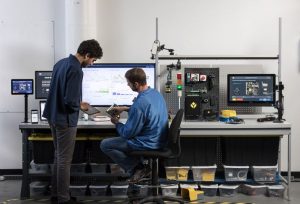Factories have always been living entities where numerous factors can throw a wrench into operations and force change. Of course, technology has long facilitated the process of making productive adjustments, and the primary vehicle today comes in the form of IoT. The internet of things begins with floor sensors collecting data and transmitting to the cloud. Software then interprets the findings and user interface empowers workers to streamline procedures.
Unfortunately, a one size fits all software is usually applied in a top-down multiyear cycle, and the status quo never obliges. “These systems solve yesterday’s problems,” states Rony Kubat. So through his research with the MIT Media Lab’s Fluid Interfaces Group, Kubat co-founded a manufacturing app that seamlessly works on the fly for your floor. The app can apply to various industries but has been particularly useful in life sciences and medical devices.
The triangulation of the IoT platform to build upon, Tulip takes a bottom-up approach to stay ahead of the curve. So real time data coming in from sensors, smart tools or cameras, and engineers can make changes to the App without adding a line of code. “Tulip is a decision making system where every step in the process is tracked,” company material states.
Clients are seeing big gains in deploying Tulip. Take for example Dentsply Sirona, the world’s largest manufacturer of dental solutions whose comprehensive catalogue of preventative, restorative, and cosmetic products are used in practices and labs world-wide, as are their best-in-class dental instruments. Through Tulip’s IoT connected kitting apps, the company reduced errors and increased traceability.
It’s also helping in the area of complex manufacturing training. For example, Tulip partnered with The Merck Group, a multinational pharmaceutical and life sciences company to help train newly hired operators. Merck used easy-to-build IoT-enabled training apps to accelerate operator training for complex manufacturing assembly processes. Merck commented, “Tulip let us take a purely paper-based system and automated it. Now, new trainees have access to the resources they need when they need it without having to rely on experienced operators.”
Of course, the digital landscape can’t efficiently adapt unless the beating heart of the factory floor is in constant contact. Instead of tracking paper and post it notes across departments and stations, interactive feedback is a click away. As such, human capital can point out hardware defects, report inefficiencies in procedure and signal when production parameters are not being met. “It’s a data-driven opportunity to engage the operators on the line,” Kubat asserted.
That said, the eye importantly goes both ways, and Tulip’s new machine vision feature helps workers minimize mistakes and improve productivity. Either way, gaining ownership over the ever changing processes, Kubat added, workers become part of a technological portability and quality control that is invaluable.
But an advanced technological process seemingly taking over doesn’t open the door for a human exit. “We’re helping companies launch products faster and improve efficiency,” Kubat said. “That means, because you can reduce the cost of making products with people, you push back the [pressure of] automation.”
So in the end, factory floors don’t ever have to hold their breath and wonder where the bolts need tightening. “Tulip provides data, when and where you need it.”























